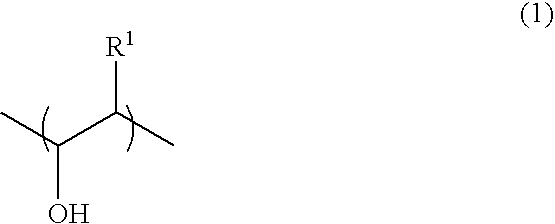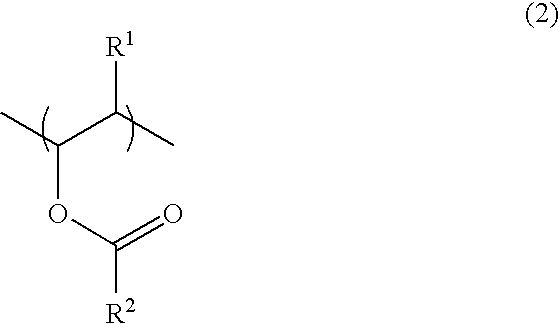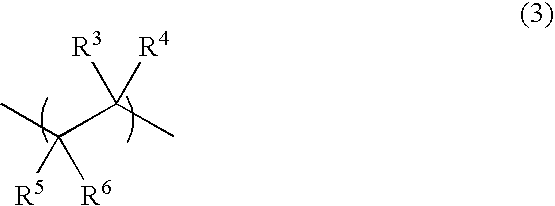Smokable polymeric casing
a polymeric and smoking technology, applied in the direction of biaxially oriented sausage casings, transportation and packaging, other domestic articles, etc., can solve the problems of unfavorable dimensional stability and uniformity, difficult production of stuffed sausages to a uniform diameter, and unstretched films suffering from undetectable wrinkles
- Summary
- Abstract
- Description
- Claims
- Application Information
AI Technical Summary
Benefits of technology
Problems solved by technology
Method used
Image
Examples
example 1
Comparative
[0075] Comparative casings were made using 1) Mowiol® 18-88, having a viscosity of about 18 (DIN 53015) mPa-s, and a hydrolysis or saponification in mol % of about 88, a nylon 6 homopolymer, and the antiblock agent, 2) 100% nylon 6 homopolymer, and 3) 100% nylon 6 / 6,6 copolymer. Table 1 gives the physical properties of these casings.
[0076] Sample 1 control casings were made with 100% nylon 6, and Sample 2 control casing with 100% nylon 6 / 6,6.
[0077] Sample 3 contained 5 wt. % of Mowiol® 18-88, 92 wt. % of nylon 6, and 3 wt. % of the antiblock.
[0078] Sample 4 contained 10 wt. % of Mowiol® 18-88, 87 wt. % of nylon 6, and 3 wt. % of the antiblock.
[0079] Sample 5 was made from 15 wt. % of Mowiol® 18-88, 82 wt. % of nylon 6 and 3 wt. % of the antiblock.
[0080] These PVC, polyamide and antiblock were mixed and loaded into an extruder and melted. Extruder temperatures ranged from 440 to 455° F. (227 to 235° C.). Die temperatures ranged from 440 to 450° F. (227 to 232° C.). T...
example 2
Comparative
[0083] Comparative casings were made with another PVA, Mowiol® 8-88, (the viscosity is approximately 8 and the hydrolysis of about 88 mol %), blended with nylon 6 / 6,6 and 3 wt. % of the antiblock concentrate. The process to make these casings were similar to the method outlined in Example 1, except that the PVA and the polyamide was mixed in the extruder hopper, instead of prior to being placed in the hopper. The formulations contained 12.5 wt. %, 15 wt. % and 30 wt. % of the PVA, with the remainder being the antiblock concentrate and the nylon 6 / 6,6. The 12.5 wt. % resin mixture was able to be run on the extruder, while the 15 and 30 wt. % caused considerable black buildup on the die, thereby making it impossible to extrude an acceptable film.
example 3
Inventive Film
[0084] The inventive film was made using the inventive PVA, Mowiflex® TC 232. Included in the blend was nylon 6 / 6,6 and 3 wt. % of the antiblock concentrate. A control of 100% nylon 6 / 6,6 was also run.
[0085] Sample 6 was the nylon 6 / 6,6 control.
[0086] Sample 7 had the formula of 15 wt. % of TC 232, 87 wt. % nylon 6 / 6,6, and 3 wt. % of the antiblock concentrate.
[0087] Samples 8, 9 and 11 contained 25 wt. % of TC 232, 72 wt. % of nylon 6 / 6,6, and 3 wt. % of the antiblock concentrate.
[0088] Sample 10 contained 35 wt. % of TC 232, 62 wt. % of nylon 6 / 6,6 and 3 wt. % of the antiblock concentrate.
[0089] Mixtures comprising TC 232, nylon 6 / 6,6, and 3 wt. % of the antiblock concentrate were loaded into an extruder and melted. Extruder temperatures ranged from 400 to 425° F. (182 to 218° C.). The die temperature was 425° F. (218° C.). The melt was extruded through an annular die and primary tube formed. The primary tube was then reheated by spraying with water at 68° C. a...
PUM
| Property | Measurement | Unit |
|---|---|---|
| Temperature | aaaaa | aaaaa |
| Weight | aaaaa | aaaaa |
| Size | aaaaa | aaaaa |
Abstract
Description
Claims
Application Information
 Login to View More
Login to View More - R&D
- Intellectual Property
- Life Sciences
- Materials
- Tech Scout
- Unparalleled Data Quality
- Higher Quality Content
- 60% Fewer Hallucinations
Browse by: Latest US Patents, China's latest patents, Technical Efficacy Thesaurus, Application Domain, Technology Topic, Popular Technical Reports.
© 2025 PatSnap. All rights reserved.Legal|Privacy policy|Modern Slavery Act Transparency Statement|Sitemap|About US| Contact US: help@patsnap.com



